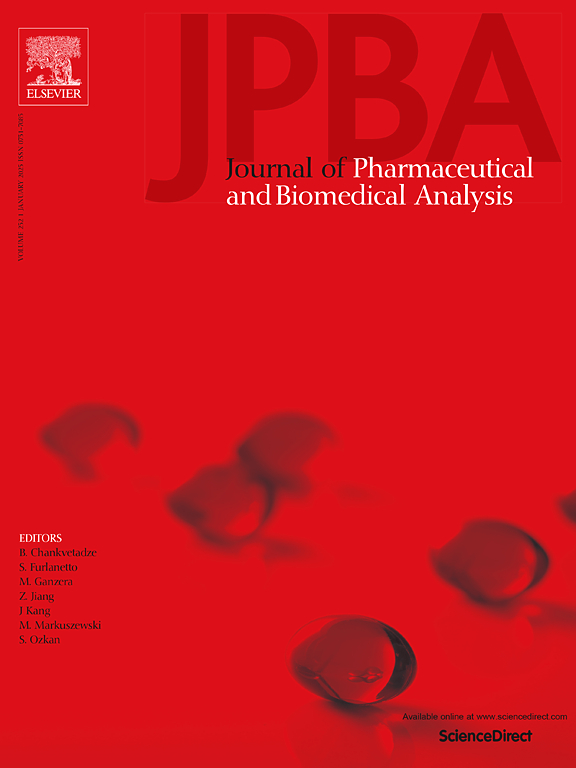A novel in-depth “static- dynamic” lipidomics workflow to reveal lipids reprogramming in hepatocellular carcinoma
IF 3.1
3区 医学
Q2 CHEMISTRY, ANALYTICAL
Journal of pharmaceutical and biomedical analysis
Pub Date : 2025-04-10
DOI:10.1016/j.jpba.2025.116880
引用次数: 0
Abstract
Hepatocellular carcinoma (HCC) is a leading cause of cancer-related deaths globally, and with current treatments proving less effective, there is an urgent need for specific biomarkers and therapeutic targets. Lipid metabolism reprogramming is a crucial cancer hallmark, yet comprehensive studies on lipid metabolic fluxes remain limited. In this study, combined with non-targeted lipidomics, a comprehensive workflow for stable isotope tracing lipidomics was established to analyze changes in lipid levels of HepG2 cells and LO2 cells from both static and dynamic perspectives. Through the screening of differential metabolites and the enrichment analysis of lipid metabolic pathways, the most significant differential metabolic pathways were found. Finally, the TCGA and CPTAC databases were utilized to analyze the gene expression levels and protein expression levels of pivotal enzymes in the differential metabolic pathways, and these findings were verified by Western Blotting experiments. The results demonstrated that the lipid metabolism of HCC was disordered, and the metabolic pathways that caused lipid changes in HCC were mainly glycerophospholipid metabolism and sphingolipid signaling pathway. LPCAT1 and SMPD1 played a crucial role in the reprogramming of lipid metabolism in HCC. The established "static-dynamic" lipidomics workflow improves the coverage and accuracy of dynamic lipid monitoring, elucidating the roles of lipids in physiological and pathological processes, providing tools for studying lipid function, and offering new perspectives on the pathogenesis of HCC as well as the identification of drug targets.
一种新的深入的“静态-动态”脂质组学工作流程揭示肝细胞癌中的脂质重编程
肝细胞癌(HCC)是全球癌症相关死亡的主要原因,目前的治疗方法证明效果较差,迫切需要特定的生物标志物和治疗靶点。脂质代谢重编程是癌症的重要标志,但对脂质代谢通量的全面研究仍然有限。本研究结合非靶向脂质组学,建立了稳定同位素示踪脂质组学的综合工作流程,从静态和动态两个角度分析HepG2细胞和LO2细胞的脂质水平变化。通过差异代谢物筛选和脂质代谢途径富集分析,发现了最显著的差异代谢途径。最后,利用TCGA和CPTAC数据库分析差异代谢途径中关键酶的基因表达水平和蛋白表达水平,并通过Western Blotting实验对结果进行验证。结果表明HCC脂质代谢紊乱,引起HCC脂质改变的代谢途径主要是甘油磷脂代谢和鞘脂信号通路。LPCAT1和SMPD1在HCC的脂质代谢重编程中发挥了关键作用。建立的“静态-动态”脂质组学工作流程提高了动态脂质监测的覆盖面和准确性,阐明了脂质在生理和病理过程中的作用,为研究脂质功能提供了工具,并为HCC的发病机制和药物靶点的确定提供了新的视角。
本文章由计算机程序翻译,如有差异,请以英文原文为准。
求助全文
约1分钟内获得全文
求助全文
来源期刊
CiteScore
6.70
自引率
5.90%
发文量
588
审稿时长
37 days
期刊介绍:
This journal is an international medium directed towards the needs of academic, clinical, government and industrial analysis by publishing original research reports and critical reviews on pharmaceutical and biomedical analysis. It covers the interdisciplinary aspects of analysis in the pharmaceutical, biomedical and clinical sciences, including developments in analytical methodology, instrumentation, computation and interpretation. Submissions on novel applications focusing on drug purity and stability studies, pharmacokinetics, therapeutic monitoring, metabolic profiling; drug-related aspects of analytical biochemistry and forensic toxicology; quality assurance in the pharmaceutical industry are also welcome.
Studies from areas of well established and poorly selective methods, such as UV-VIS spectrophotometry (including derivative and multi-wavelength measurements), basic electroanalytical (potentiometric, polarographic and voltammetric) methods, fluorimetry, flow-injection analysis, etc. are accepted for publication in exceptional cases only, if a unique and substantial advantage over presently known systems is demonstrated. The same applies to the assay of simple drug formulations by any kind of methods and the determination of drugs in biological samples based merely on spiked samples. Drug purity/stability studies should contain information on the structure elucidation of the impurities/degradants.

 求助内容:
求助内容: 应助结果提醒方式:
应助结果提醒方式:


